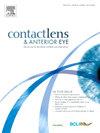正视镜对控制过敏性结膜炎患儿近视发展的长期效果。
IF 3.7
3区 医学
Q1 OPHTHALMOLOGY
引用次数: 0
摘要
背景:目的:观察过敏性结膜炎(AC)患儿配戴正角膜塑形镜(OK)三年后,其近视控制效果是否与无过敏性结膜炎(nAC)患儿不同,并找出潜在的影响因素:这是一项回顾性病例对照研究。方法:这是一项回顾性病例对照研究,收集了在 2019 年配戴 OK 镜片的 8-15 岁患者。同时还进行了为期三年的随访,记录了所有角膜不良事件(AE)以及配戴 OK 镜三年后眼轴长度(AL)的增加情况。根据患者的病史和初次验配时的体征,将患者分为有角膜刺激症状和无角膜刺激症状两组。比较两组患者的基线数据和三年后的AL伸长率:本研究共纳入 309 名患者,其中 AC 组 47 人,nAC 组 262 人。两组患者在年龄、性别、球面等值(SE)、眼球角膜厚度(AL)和环境方面均无统计学差异。佩戴 OK 镜三年后,AC 组的 AL 伸长率为 0.96 ± 0.45 毫米,而 nAC 组为 0.69 ± 0.45 毫米(P 结论:AC 组的 AL 伸长率为 0.96 ± 0.45 毫米,而 nAC 组为 0.69 ± 0.45 毫米):本研究发现,过敏性结膜炎会影响 OK 镜三年后控制近视的效果。本文章由计算机程序翻译,如有差异,请以英文原文为准。
Long-term effect of orthokeratology on controlling myopia progression in children with allergic conjunctivitis
Background
To observe whether the effect of orthokeratology (OK) lenses on myopia control in children with allergic conjunctivitis (AC) after three years of wear differs from that in children without allergic conjunctivitis (nAC) and to identify the potential influencing factors.
Methods
This was a retrospective case–control study. Patients aged 8–15 years who were fitted with OK lenses in 2019 were collected. A three-year follow-up was also conducted, documenting all corneal adverse events (AEs) and the increase in axial length (AL) of the eye after three years of wearing OK lenses. Patients were divided into groups with and without AC based on their medical history and physical signs at the initial fitting. Baseline data and AL elongation after three years were compared between the two groups.
Results
A total of 309 patients were included in this study, with 47 in the AC group and 262 in the nAC group. There were no statistically significant differences between the two groups in terms of age, sex, spherical equivalent (SE), AL of the eye and environment. After three years of OK lens wear, the AL elongation in the AC group was 0.96 ± 0.45 mm, whereas it was 0.69 ± 0.45 mm in the nAC group (P < 0.001). The extent of AL elongation in AC patients was significantly greater than that in nAC patients. During the three-year follow-up period, the duration of OK lenses discontinuation due to corneal AEs in the AC group was greater than that in the nAC group (P < 0.05).
Conclusions
This study found that allergic conjunctivitis can affect the efficacy of OK lenses in controlling myopia after three years of treatment.
求助全文
通过发布文献求助,成功后即可免费获取论文全文。
去求助
来源期刊

Contact Lens & Anterior Eye
OPHTHALMOLOGY-
CiteScore
7.60
自引率
18.80%
发文量
198
审稿时长
55 days
期刊介绍:
Contact Lens & Anterior Eye is a research-based journal covering all aspects of contact lens theory and practice, including original articles on invention and innovations, as well as the regular features of: Case Reports; Literary Reviews; Editorials; Instrumentation and Techniques and Dates of Professional Meetings.
 求助内容:
求助内容: 应助结果提醒方式:
应助结果提醒方式:


